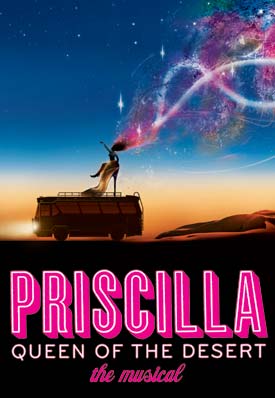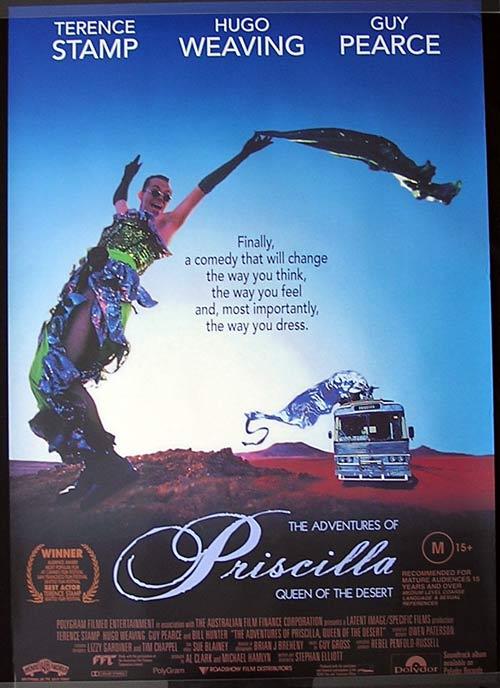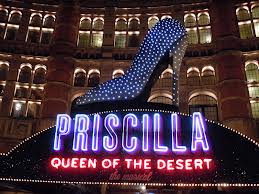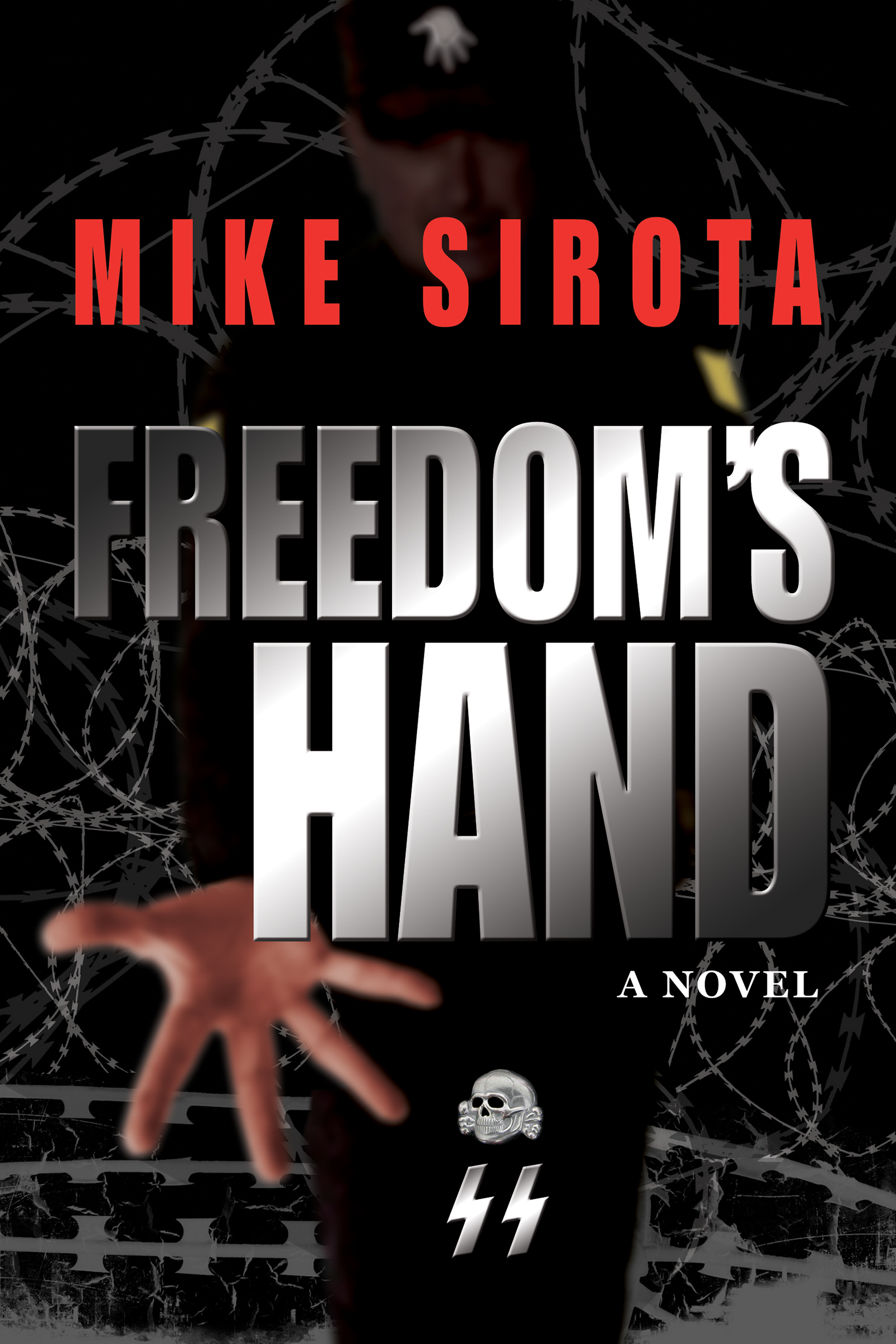I had the great pleasure of seeing the musical stage production of Priscilla, Queen of the Desert here in San Diego last month. Most of the twenty or so familiar songs are still rolling around in my head, and they are more than welcome there. But above  all the laughs, the music, and the glitz, the message of this show is one of tolerance and love—and on that score, Priscilla hits the high note.
all the laughs, the music, and the glitz, the message of this show is one of tolerance and love—and on that score, Priscilla hits the high note.
The musical version came to life as an offshoot of an initially obscure 1994 Australian movie—full title, The Adventures of Priscilla, Queen of the Desert. The film, although not a musical, did have a number of songs in it, most of which became part of the stage production, which opened in 2006. And the core story, for the most part, remains intact and works just as well on-stage as on the screen.
Drag queen Anthony is a Sydney-based performer aka Mitzi. In the movie he was played by Hugo Weaving. (Yes, Agent Smith and Elrond!) Anthony’s wife (though long separated after he came out of the closet, they are not divorced) manages a casino resort in the central Australia town of Alice Springs. She asks Anthony to do his drag act there, and he agrees, partly because he wants to see their now eight-year-old son for the first time since he was a baby. He asks young Adam, another drag queen—aka Felicia—and a middle-aged transsexual, Bernadette, to join him. The trio, in a broken-down bus dubbed Priscilla, “Go West”—in the words of the Village People—toward the Outback.
Homophobia strikes early when, after doing their thing at a bar in a small town, the  trio finds Priscilla painted with graffiti. (In the film: “AIDS Fuckers Go Home.” There is a similar message on the bus in the stage production.) But they also find a warm welcome and understanding from a group of Aborigines, for whom they perform in full drag as they lip-sync to “I Will Survive.” The scene in the film, where the Aborigines joyfully sing, dance, and accompany them on the didgeridoo: PRICELESS.
trio finds Priscilla painted with graffiti. (In the film: “AIDS Fuckers Go Home.” There is a similar message on the bus in the stage production.) But they also find a warm welcome and understanding from a group of Aborigines, for whom they perform in full drag as they lip-sync to “I Will Survive.” The scene in the film, where the Aborigines joyfully sing, dance, and accompany them on the didgeridoo: PRICELESS.
When Priscilla breaks down in the middle of the Outback, the trio enlists the help of a middle-aged mechanic named Bob who, knowing that the bus is in bad shape, joins the party. He is attracted to Bernadette, whom he had seen perform many years earlier when she was a male drag queen. They stop in the town where Bob lives and meet his shrewish, neurotic “mail-order wife,” Cynthia. Later, as the trio does their thing at a pub, they are pushed off-stage by Cynthia, who does a frenzied dance to the sound of “Pop Muzik” and, to the delight of the audience, pops ping pong balls at them from her vagina. (I kid you not!) The humiliated Bob drags her away, but it appears their relationship is over.
At an ultra-redneck mining town the troubled Adam downs some drugs, becomes Felicia and teases the coarse men. When they realize who and what he is, they nearly kill him. Bernadette and Bob come to his rescue. Bernadette later comforts Adam, easing their previously tense relationship and further endearing her to Bob.
SPOILER ALERT for the remainder of the plot: they finally arrive in Alice Springs, where Anthony is panicky about what his son, Benjamin, might think of him. But the  boy already knows about his father’s lifestyle and has no problem with it. To the heartfelt, “You Were Always on my Mind,” their reunion is poignant, and their future relationship promising—as is that of Bernadette and Bob.
boy already knows about his father’s lifestyle and has no problem with it. To the heartfelt, “You Were Always on my Mind,” their reunion is poignant, and their future relationship promising—as is that of Bernadette and Bob.
For Adam/Felicia, one of his goals in coming to the Outback was to climb to the top of the famous landmark called Uluru—formerly known as Ayers Rock—in full drag. (“A cock in a frock on a rock,” he says.) He accomplishes this, with Anthony and Bernadette at his side.
The film and the musical have different endings, but no matter—the goals of each were resoundingly met, with the future hope for tolerance and acceptance evident. Should the musical ever come to your neck of the woods, it’s a must-see. For now, the movie is easily available.
TOLERANCE? I THINK NOT…
Intolerance, bigotry, racism dominate the pages of my latest novel, a thriller titled Freedom’s Hand. The book’s title is also the name of a white supremacist group that, driven by one man’s twisted vision, has constructed a concentration camp, modeled after Auschwitz, in the desert of the American Southwest. The goal: to destroy this nation’s African-Americans, Jews, gays, Latinos, Asian-Americans, and anyone else who is not—like them.
Can horrors like this happen? Well, they have…in many different countries, in many different eras.
One recent review said a great deal: “The premise of this first class thriller initially seemed a bit improbable, but it quickly sucked me in. A master of technique, Sirota  dazzles with his ability to effortlessly juggle points of view and flashbacks for devastating dramatic effect. The book is as much of a technical feat as it is a gripping, unflinching tale of brutality. And just when you think that the violent action is too over-the-top to be believable, you realize that this stuff actually happened in another time and place. This book makes you think about historical horrors in a new light, and perhaps to wonder why it took Sirota’s story to make us fully appreciate the genocidal evils of seventy years ago.”
dazzles with his ability to effortlessly juggle points of view and flashbacks for devastating dramatic effect. The book is as much of a technical feat as it is a gripping, unflinching tale of brutality. And just when you think that the violent action is too over-the-top to be believable, you realize that this stuff actually happened in another time and place. This book makes you think about historical horrors in a new light, and perhaps to wonder why it took Sirota’s story to make us fully appreciate the genocidal evils of seventy years ago.”

It seems that you guys have the time to do all kinds of fun stuff. Or at least that you know how to make the time for it.
I love the movie version of “Priscilla” and can only imagine how well it translates to the stage, given that it’s already a performance piece, of sorts. The costumes alone had to be over the top.
And, um…no…there isn’t even a hint of tolerance for the sorts of characters that inhabit “Priscilla” in “Freedom’s Hand”. While one can be encouraged that such movies and musicals exist, we must also remain aware of the reality presented by your (unfortunately) timeless book. People just like those horrifying characters parade across our TV screens on a daily basis.
You’re right, we MAKE the time for fun. Metaphorically, as ABBA once sang: “What would life be–without a song or a dance what are we?”
As for the stage play, you almost needed sunglasses–the costumes were so dazzling.